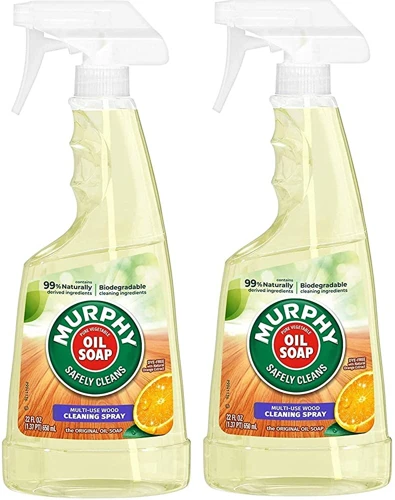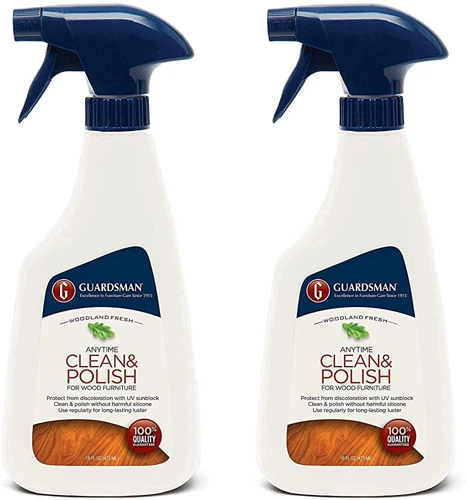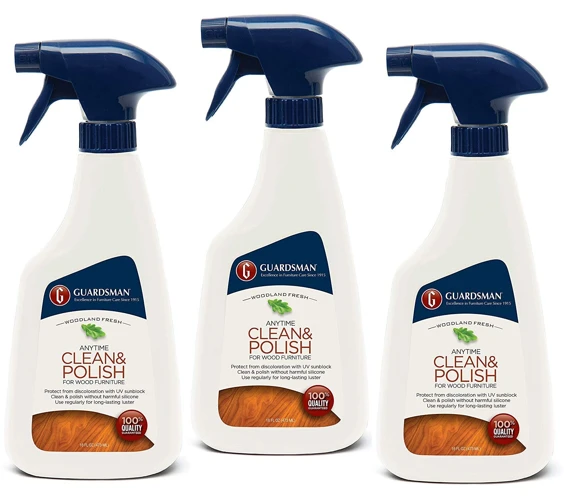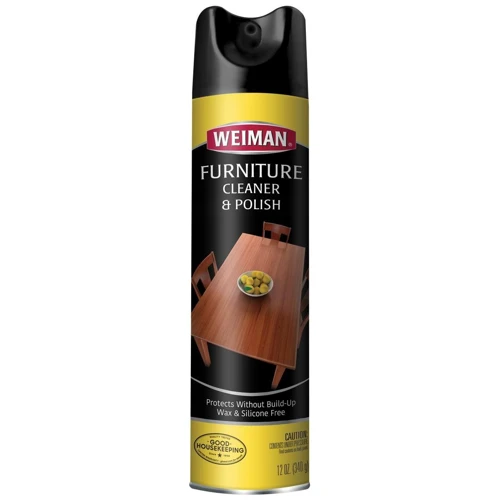Introduction

Taking care of your furniture is essential to maintain its beauty and prolong its lifespan. Properly applying furniture polish is one of the most crucial steps to achieve a streak-free shine and protect the surface from potential damage. However, with so many types of polish available in the market, choosing the right one and applying it correctly can be a daunting task. In this article, we will provide you with step-by-step instructions on how to properly apply furniture polish to achieve the best possible results. By following these guidelines, your furniture will shine like new for years to come.
Why Proper Application is Important
Proper application of furniture polish is crucial in maintaining the beauty and longevity of your furniture. Furniture polish not only enhances the shine and appearance of your furniture but also helps to protect it from damage. Without proper application, however, it can lead to streaks, build-up, and even damage to the surface of your furniture.
Streaks
One of the most common issues with improper furniture polish application is the presence of streaks. Streaks can occur when too much polish is applied, or when the polish is not buffed evenly. This can take away from the beauty of your furniture and make it look dull and unattractive.
Build-up
Another issue that can arise from improper application is the build-up of polish. This can occur when furniture polish is applied too frequently or when an excess amount is used. Build-up can lead to a sticky or greasy surface and can be challenging to remove.
Damage
Finally, improper furniture polish application can lead to damage to the surface of your furniture. This can occur when harsh chemicals in the polish are left on for too long or when an abrasive cloth is used to buff the furniture. This can cause fading or cracking of the furniture.
To avoid these issues, it is important to follow proper furniture polish application techniques, which we will discuss in further detail in this article.
If you want to learn more about the benefits of using natural furniture polish, check out our article on natural furniture polish benefits. If you’re trying to decide between spray and liquid furniture polish, we also have an article on spray vs liquid furniture polish that can help you make an informed decision. And, if you’re wondering how furniture polish can prevent cracking and fading, read our article on furniture polish to prevent cracking and fading. Finally, if you want to know the difference between wax and polish for furniture, check out wax vs polish for furniture.
What You Will Need

Before you get started with polishing your furniture, it’s important to gather all the necessary supplies. Don’t forget anything, as having to stop in the middle of the process can be frustrating! Here are some must-have items: supplies for cleaning, polishing, and buffing. Don’t worry, we’ll guide you through each one.
List of Supplies
To properly apply furniture polish, you will need the right tools and supplies. Here is a table listing the essential supplies you will need:
| Supplies | Description |
|---|---|
| Furniture polish | Choose a polish that is appropriate for your furniture’s material and finish. |
| Microfiber cloths | These cloths are soft and gentle, but effective at trapping dust and dirt. Avoid using rags or old T-shirts as they may contain debris that could scratch your furniture. |
| Cleaning solution | Choose a cleaning solution that is safe for your furniture material. Avoid using harsh chemicals that can damage your furniture. |
| Stain remover | If your furniture has any stains or grime buildup, you may need to use a stain remover before applying polish. |
| Bowl of warm water | Warm water can help remove dirt and grime from your furniture. |
| Dry cloth | You will need a dry cloth to wipe off any excess polish and to buff your furniture after applying the polish. |
Make sure you have all the supplies listed above before you begin applying furniture polish. This will ensure that you can clean your furniture properly and apply the polish in the most effective way.
Preparing Your Furniture

Before applying furniture polish, it is important to properly prepare your furniture. This step is crucial in ensuring that the polish can effectively enhance the appearance of your furniture without any streaks or residue. Take a moment to follow these steps carefully, and your furniture will thank you for it.
Cleaning Your Furniture
Before applying furniture polish, it’s important to properly clean your furniture. Cleaning your furniture will ensure that you get the best possible shine and that the polish doesn’t trap any dirt or dust. Here are the steps to follow for properly cleaning your furniture:
Step 1: Remove any dust or loose debris from your furniture with a soft cloth or a vacuum cleaner. Be gentle when removing dust to avoid scratching the furniture’s surface.
Step 2: Next, prepare a cleaning solution. Mix a small amount of dish soap with warm water in a bucket. Dip a soft cloth into the solution and wring it out until it’s only damp.
Step 3: Gently wipe the surface of the furniture with the damp cloth. Be sure to clean in the direction of the grain to avoid damaging the surface. Avoid using too much water or allowing the furniture to become saturated, as this can cause damage.
Step 4: For any stubborn stains, use a furniture-safe cleaner or make a paste of baking soda and water. Apply the cleaner to a soft cloth or sponge and gently scrub the affected area. Rinse the area with a clean and damp cloth to remove any remaining cleaner.
Step 5: Once you have thoroughly cleaned the furniture, use a clean and dry cloth to remove any excess water. Allow the furniture to air dry completely before moving on to the next step.
By following these simple steps, you can be sure that your furniture is properly cleaned and ready for polishing.
Removing Stains and Grime
Removing stains and grime from your furniture is important before applying furniture polish for a streak-free shine. Follow these steps to prepare your furniture for polishing:
| Step | Instructions |
|---|---|
| Step 1 | Identify the type of stain or grime on your furniture. Common stains include watermarks, ink stains, and food stains. Grease and grime can be caused by dirt and oils. |
| Step 2 | Choose the appropriate cleaning solution for your furniture type and the type of stain or grime. Wood furniture may require a different solution than leather or fabric furniture. Be sure to follow the manufacturer’s instructions. |
| Step 3 | Apply a small amount of the cleaning solution onto a clean, soft cloth. Avoid using abrasive cloths or sponges, as they can scratch or damage your furniture. |
| Step 4 | Test the cleaning solution on a small, hidden area of your furniture to make sure it does not cause any damage or discoloration. Wait for a few minutes before wiping it off. |
| Step 5 | Begin cleaning the stained or grimy area by gently rubbing the cloth in a circular motion. Avoid rubbing too hard, as this can damage your furniture. Always work from the outside of the stain towards the center to avoid spreading the stain. |
| Step 6 | Repeat this process until the stain or grime is completely removed. |
By taking the time to properly remove stains and grime from your furniture, you can ensure that the surface is clean and ready to be polished to a streak-free shine.
Drying Your Furniture
Once your furniture is clean, it’s important to thoroughly dry it before applying any furniture polish. Here are the steps for drying your furniture:
| Step 1: | Use a clean, dry microfiber cloth to wipe down the entire surface of your furniture. |
| Step 2: | If there are any areas that are still damp, use a dry corner of your cloth to soak up any excess moisture. |
| Step 3: | Allow your furniture to air dry completely before applying any furniture polish. Avoid placing it near a heater or in direct sunlight, as this can cause the wood to warp or crack. |
It’s important to make sure your furniture is completely dry before applying any furniture polish, as any moisture left on the surface can prevent the polish from bonding properly, and can even cause damage to the wood. Make sure to give your furniture enough time to air dry before proceeding to the next step.
Applying Furniture Polish

One of the most dreaded household chores is polishing furniture. However, when done correctly, it can leave a stunning finish that will make your furniture look brand new. Before diving into the polishing process, it is important to select the right polish and complete the necessary preparation steps. In this section, we will discuss the step-by-step approach to applying furniture polish, including how to test it on a small area and the techniques for buffing your furniture to a streak-free shine.
Choosing the Right Polish
When choosing the right polish for your furniture, it is important to consider the type of wood or material it is made of. Using the wrong type of polish can cause damage to your furniture or leave behind streaks and residue. Here are some key points to keep in mind when selecting the right polish:
- Check the label: Make sure the label clearly states the type of furniture it’s suitable for. Some polishes are specifically formulated for certain types of wood or finishes, so it’s essential to read the label before making a purchase.
- Avoid silicone-based polishes: Water and silicone-based polishes can build up over time and make it difficult to refinish or repair your furniture. Look for oil-based polishes that penetrate the wood and provide a long-lasting shine.
- Consider the sheen: Different polishes offer various levels of shine, from high gloss to matte. Choose a polish with a finish that complements your furniture’s natural aesthetic.
- Think about fragrance: If you or anyone in your household has allergies or sensitivity towards chemicals, consider using a fragrance-free polish. Some scented polishes can emit toxic fumes that can trigger allergies or other respiratory problems.
By taking the time to select the right polish for your furniture, you can ensure a long-lasting shine and prevent damage to the wood or finish. Remember also to apply the polish in a well-ventilated area, follow the manufacturer’s instructions, and store the polish in a cool, dry place.
Testing on a Small Area
Before applying furniture polish extensively, it is important to test it on a small area. This is to ensure that the polish doesn’t negatively affect the furniture finish or cause any discoloration. Here are some steps to follow when testing the polish:
- Identify a small inconspicuous area on the furniture: This could be an underside or backside of the furniture piece.
- Apply a small amount of polish: Using a clean cloth or a cotton ball, apply a small amount of polish on the identified area. Be sure not to over-saturate the area.
- Wait and observe: Wait for a minute or two to see if any discoloration or damage occurs on the furniture. If there is any discoloration or damage, stop the application and do not continue to use the polish on that furniture piece.
- Check for compatibility: If the polish doesn’t cause any damage, check if the polish is compatible with the furniture finish by running a cloth or cotton ball over the test area. If there is no smudging or discoloration, it is safe to proceed with the polish application on the rest of the furniture.
Testing on a small area before applying the polish on the entire furniture piece will save you from potential damage and ensure the longevity of your furniture.
Applying the Polish
Applying the polish is the final step to achieve that shiny and protective layer on your furniture. Follow the steps below to ensure a streak-free finish:
| Step 1: | Shake the bottle of furniture polish well before using it. This will help to mix the ingredients well and distribute them evenly. |
| Step 2: | Spray a small amount of polish onto a clean and dry microfiber cloth or a damp sponge. Avoid spraying directly onto the furniture, as excess polish may result in a streaky finish. |
| Step 3: | Gently apply the polish onto the furniture, using circular motions. Start from the top and work your way down, covering one section at a time. |
| Step 4: | Be careful not to apply too much pressure, as this may result in smears or damage to the surface of the furniture. |
| Step 5: | Allow the polish to dry completely before buffing it with a clean and dry microfiber cloth. This will help to remove any excess polish and give your furniture a shiny finish. |
Remember to avoid applying too much polish, as this may result in a build-up of residue that attracts dust and dirt. Using a microfiber cloth or a damp sponge will also help to prevent streaks and ensure an even application. With these simple steps, you can now enjoy the benefits of a properly polished and protected furniture.
Buffing Your Furniture
Once you have applied the furniture polish and allowed it to dry, it is time to buff your furniture for a streak-free shine. This is a critical step that should not be skipped. Buffing helps to remove any excess polish and evenly distribute the remaining polish to create a smooth and shiny surface. There are several steps to follow for successful buffing:
- Choose the right cloth: Use a soft, clean cloth made of a natural material like cotton or microfiber. Avoid using rough or abrasive materials, as they can scratch the surface of the furniture.
- Start buffing: Begin by gently rubbing the cloth over the furniture in a circular motion. Apply light pressure and work in small sections to ensure complete coverage.
- Change the cloth: As you buff, the cloth will become saturated with polish. Switch to a clean portion of the cloth or change to a new one to avoid re-applying oil and creating streaks.
- Pay attention to details: Don’t forget to buff hard-to-reach areas like corners and edges. Use a smaller cloth or a cotton swab to get into tight spaces.
Remember not to over-buff your furniture as this can remove the polish and leave the surface dull. Take your time, and buff until you achieve the desired shine. Once you are finished buffing, step back, and admire your streak-free furniture.
Additional Tips
As you complete the furniture polishing process, there are a few additional tips that can help ensure the longevity and shine of your furniture. These tips may seem small, but they can make a big difference in the overall appearance and health of your pieces. So, before you pack up your supplies, take a few moments to review these important suggestions. Your efforts will be rewarded with furniture that looks and feels its best for years to come.
How Often to Polish Your Furniture
It is important to maintain your furniture to keep it looking its best. One question that you may have is how often should you polish your furniture to keep it looking great? The answer depends on the type of furniture you have and how frequently you use it.
Here is a table to help you determine how often to polish your furniture:
| Type of Furniture | Frequency of Polishing |
|---|---|
| Antique or delicate furniture | Every 6-12 months |
| Modern furniture with a lacquer finish | Every 3-6 months |
| Wood furniture with an oil finish | Every 6-12 months |
| Leather furniture | Every 6-12 months |
| Metal furniture | Every 6-12 months |
Keep in mind that these are general recommendations, and the frequency of polishing could vary depending on the specific conditions in your home. For example, if you live in a dusty area, you may need to polish more frequently.
Remember: Over-polishing can actually damage your furniture, so be sure to follow the recommended frequency and use a high-quality furniture polish.
By following these guidelines, your furniture will look great and last for years to come.
Store Polish Properly
When it comes to prolonging the life of your furniture polish, it’s essential to store it correctly. Proper storage will keep the product from being exposed to damaging elements that could cause it to spoil and lose its potency. Here are some tips to help you store your furniture polish properly:
| Tip | Description |
|---|---|
| Keep it in a cool, dry place | Furniture polish can degrade when exposed to excessive heat or humidity. Keep the product in a cool, dry place, like a closet or a cupboard away from the sun. |
| Seal the container | Closing the container tightly can keep air and moisture from getting in, which can affect the quality and consistency of the polish. |
| Avoid extreme temperatures | Furniture polish can freeze or melt at extreme temperatures. Avoid storing it in areas like the basement or attic or in a car subjected to temperature fluctuations. |
| Don’t store near food or pets | Furniture polish can be toxic if ingested by pets or humans. Keep the container away from food and drinks and in a locked cupboard out of reach of children and pets. |
Following these tips will protect your furniture polish and help it last longer. Proper storage also saves you money since you won’t need to replace the polish frequently. Make sure to check the label or manufacturer’s instructions for specific storage directions to maximize the lifespan of your furniture polish.
Conclusion
In conclusion, properly applying furniture polish is an essential step in maintaining the shine and longevity of your furniture. Using the right supplies and preparation techniques will ensure a streak-free and long-lasting result. Remember to clean your furniture thoroughly, removing any stains and grime, and allowing it to dry completely before applying the polish. Be sure to choose the right polish for your furniture and test it on a small, inconspicuous area before applying it to the entire piece. The application process should be done gently and without any excess polish left on the furniture. Finally, buff your furniture after the polish has been applied to achieve a beautiful, long-lasting shine. By following these tips and tricks, your furniture will look as good as the day you bought it for years to come. Remember to store your polish properly, and maintain your furniture by polishing it regularly. With a little effort, you can keep your furniture beautiful, clean, and shining.
Frequently Asked Questions
What is furniture polish?
Furniture polish is a type of product made from different ingredients that are used to dust, clean, and polish furniture surfaces to give them a shiny and glossy appearance.
Why use furniture polish?
Furniture polish helps to enhance the appearance of your furniture, protect it from damage by creating a barrier from moisture, dust and dirt, and helps to make the cleaning process easier by preventing buildup.
What type of polish should I use on my furniture?
The type of polish you use on your furniture depends on the material of the furniture. For wooden furniture, use a polish that contains wax to protect it from moisture and dust. For leather furniture, choose a polish made specifically for leather.
How often should I polish my furniture?
You should polish your furniture every 3-6 months to keep it clean and shiny.
How do I test a polish before applying it to my furniture?
Test the polish on an inconspicuous area of the furniture before applying it to the entire surface. This helps to ensure the polish does not discolor or damage the furniture.
Can I use furniture polish on other types of surfaces besides wood?
Most furniture polish products are designed to be used on wood furniture, but there are some multi-surface polishes made for use on other surfaces such as glass and metal. Check the label to make sure the product is safe for your specific surface.
Can I make my own furniture polish?
Yes, you can make your own furniture polish using natural ingredients such as olive oil or beeswax. There are many DIY recipes available online, but be sure to test them on a small area first.
What should I do if I accidentally apply too much polish?
If you apply too much polish, use a clean cloth to wipe away the excess.
Is it safe to use furniture polish around my children and pets?
Most furniture polish products are safe to use around children and pets, but it is always a good idea to read the label and follow the safety instructions.
What should I do if my furniture still looks dull after applying polish?
If your furniture still looks dull after applying polish, it may be time to refinish or replace it.
